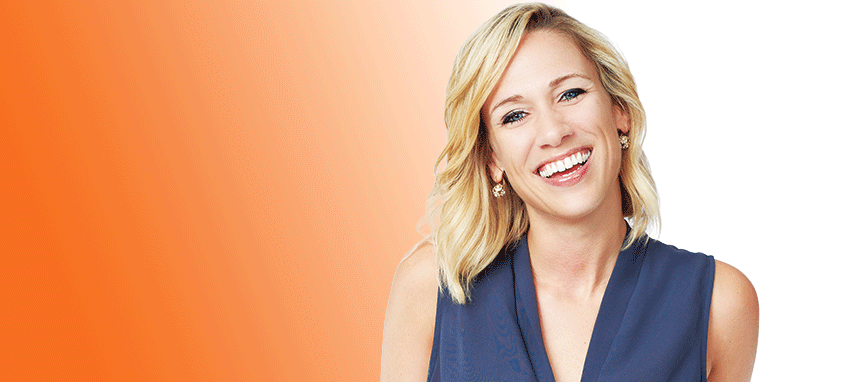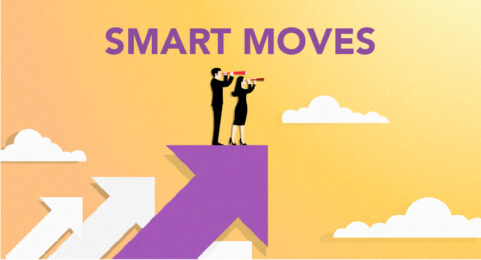Or why paying people to perform actually doesn’t work
Charlotte Blank can predict how you would react if someone offered you $500. Better than you can, in fact. That’s because Maritz’s chief behavioral officer understands your emotional triggers. This key contributor to a new forum called PeopleScience takes the latest behavioral research at leading universities and tries it out in the real world to test what really motivates people—and what doesn’t.
That $500, for instance—you might think getting such a nifty bonus from your boss might make you a happier employee, but it could actually decrease your productivity. But if that same amount was donated in your name to someone else, the opposite could happen, with the afterglow inspiring you to become a better worker. Then the scenarios get really interesting. If the cash was replaced by special recognition from the CEO and an event where you were honored, you could probably find the extra energy to reach an ambitious stretch goal. In fact, for such an ego boost you might forego as much as—are you ready?—a whopping $30,000, if you saw the recognition as a big deal to your peers.
Welcome to the science of incentives, where cash is not king. Not always, anyway.
Beyond the Carrot

Edward Maritz is credited with inventing the incentive space a century ago when he started selling watches to corporations to use as awards for employees. The company added group trips in the 1950s to motivate performance. In the last 20 years, the company has placed a hyper-focus on advancing a scientific understanding of human behavior in the corporate world.
Today, Blank travels the country, working with Fortune 500 companies and thought leaders from academia to collect data at the edges of our understanding of what really motivates people. “Don’t just do it—test it” is her mantra.
Over the years, professors have tested students using marshmallows, candy bars—and even electric shocks back in the 1960s—but no one knew if those student decisions would translate to $100,000 incentive programs in the messy real world—where decision-making can be impacted by overlapping motivators.
Blank’s goal for her team is to bridge the gap between low-stakes nudges in college laboratories, and government programs designed to motivate us to do things such as paying our taxes on time or recycling, and complex quotas for channel partners that have real economic consequences on the national GDP and people’s happiness and livelihoods.
“We spend three to five times more on incentives than on advertising in this country, but we rarely test what is resonating—as we do with an ad,” Blank observes. In total, U.S. companies spend more than $800 billion each year to reward employees for jobs well done. In many cases, however, programs are simply run as they have been done for decades. She sees randomized, controlled trials as the best way to try new things and unleash the untapped potential of the workforce. “This is an opportunity for business leaders to inspire people to come on a success journey. Let’s make it as effective as possible,” she says.
She shares such insights through the PeopleScience platform, which launched in April. Other contributors include Matt Wallaert, chief behavioral officer at Clover Health; Kevin Brilliant, business strategy and analytics senior manager for NBA’s Chicago Bulls; and Om Marwah, global head of behavioral science for Walmart.
Blank calls her work “applied performance psychology.” Its surprising revelations could forever change sales contests and production goals, making them into more effective contributors to the bottom line—and something employees actually look forward to.
Predicting the Irrational
Behavioral science has shown that the assumption that people act as rational economic calculators is wildly wrong. The good news is, those counter-intuitive tendencies follow a pattern. That’s the takeaway from another PeopleScience contributor, Duke University Professor of Psychology and Behavioral Economics Dan Ariely. His book, Predictably Irrational: The Hidden Forces That Shape Our Decisions, has launched a thousand tests of how people react as part of a group (or team).
One of those counter-intuitive, but nearly universal, truths is that people are motivated more by a cause than by cash.
“Money, as it turns out, is very often the most expensive way to motivate people,” Ariely concludes. “Social norms are not only cheaper, but often more effective as well.”
In his 2016 book, Payoff: The Hidden Logic that Shapes our Motivations, he describes a real-world test in 2013 at an Intel semiconductor factory in Israel. He gave workers a cash bonus if they met a higher quota. Many rallied and reached the stretch goal. However, the second the money was in their pockets, productivity dropped—and not just back to previous levels, but below them.
Other groups were incentivized with a voucher for pizza they could take home to enjoy with their families (the “experience” group) or with a “Well done!” text from the boss (the “compliment” group). Both groups increased productivity by more than 6 percent compared to groups which were not incentivized. And, more importantly, they continued to produce at higher levels.
Blank describes this as a classic case of financial incentives having only short-term benefit. He says similar results have shown up in experiment after experiment.
“Cash is not king. In fact, it can hurt more than it helps,” Blank says. When it comes to motivating incremental and discretionary effort, rewards other than dollars get people to reach inside themselves and find that turbo charge in order to sell that one more thing.
Paying It Forward
Another way to tap into core human needs in order to motivate behavior is to leverage the power of what researchers call “prosocial spending.” At all ages and across the country, scientists have documented the mental, emotional and motivational power of giving. Research by University of British Columbia Professor Elizabeth Dunn showed that, whether it was goldfish crackers or $100 bills, those who gave the rewards away experienced greater happiness than those who kept the incentives for themselves.
A new study published in May by researchers at Washington University and Harvard Business School as part of a Maritz field research collaborative found that the same prosocial power applies to refer-a-friend programs and loyalty rewards programs. Giving is good for the recipient, the company and the giver.
The conclusion from studying the actions of such disparate groups as bankers in Australia and pharmaceutical salespeople in Belgium, Blank says, is that “when organizations give employees the opportunity to spend money on others—whether their co-workers or those in need—both the employees and the company can benefit with increased happiness and job satisfaction and even improved team performance.”
Indeed, research by Lalin Anik from University of Virginia Darden School of Business, Ashley Whillans at Harvard Business School and Lara Aknin at Simon Fraser University shows that, on average, the sales lift from standard cash bonuses isn’t enough to cover the cost of the bonus. But when rewards are shared with teammates, they more than pay for themselves.
“Over the long term, giving can even reduce blood pressure to the same extent as starting a new cardio routine,” Blank asserts.
Pride and Promotion
Ego is incredibly motivating. Research underscores that we humans excel at comparing ourselves to the person in the next cubical. Blank points to a study by Ian Larkin, a professor at UCLA. He used data from a software company where salespeople participate in a lucrative commission program, but also are eligible for status-based rewards. Namely, a president’s club that includes a trophy, a pat on the back and a group trip to a tropical destination. This rock-star recognition has a catch—it sets goals on a timeline that minimizes progress toward the financial payout. The result? On average, people are willing to give up $30,000 in commissions for the status and gold star.
“Recognition is a fundamental motivator,” Blank says.
Earned rewards are seen as more valuable because of the power of social reinforcement. What that tropical trip says to peers, supervisors, family and friends is that a participant has performed well. It becomes a source of pride—and is therefore more valuable.
Competitive Analysis
Competition is a related area of research Blank would like to see explored more fully. The decision about whether to have employees compete against each other, or against themselves or specific goals, should depend on their status and sense of self-worth. For superstars, competition can rev engines, but comparing a junior member to a veteran could crush the newbie’s motivation and lower expectations.
Michael Ahearne, a researcher from University of Houston, divides sales teams into stars, core performers and laggards. The author (along with Gerald Manning and Barry Reece) of Selling Today: Partnering to Create Value suggests “get better” rather than “be good” goals to recognize development.
Targets must also be set carefully. Blank points to data that shows finishing times in marathons are clustered around arbitrary time markers—3 1/2 hours, four hours and so on. People find it in themselves to hit those goals, but no more. Similarly, when designing a motivation program, tiers must be within reach, but also at intervals that give people something to strive for. “Numbers create a magnetic pull, but they don’t have the same effect on everyone, so you have to consider all members of the group,” Blank concludes.
One way to even out the peaks is to carefully design progress feedback. In the beginning, report how much has been accomplished. After the halfway point, report what is left to reach the goal. “Emphasize the smaller part of the curve. That can have an outside impact on performance,” Blank says.
Research has also found that giving people autonomy—a sense of owning a piece of the program—is a powerful way to boost participation. It imparts a sense of ownership and buy in.
Finally, the program and prize need to be interesting enough to win attention.
Predicting Values
Preference does not equal performance—that’s the conclusion of a body of work by Scott Jeffrey, a professor in the department of management and decision sciences at Monmouth University in New Jersey. He surveyed MBA students at University of Chicago to find out if they would choose a $5,000 bonus or a trip to Hawaii worth $5,000. An overwhelming majority, 83 percent, said they would prefer the cash award.
However, when asked which reward was the more powerful motivator, the trip won.
Jeffrey theorizes that we have all been taught that money is always better than nonmonetary incentives because it allows us to buy exactly what we want, or to use it for something practical, such as bills. However, money rewards are no more memorable than base salary—and therefore not as effective. He suggests that the utility of the prize is determined by the emotional response to the idea of the experience. And because the value of a trip is ambiguous, participants tend to increase its perceived worth.
The Bottom Line
Companies use data to make decisions in so many areas, so why not turn to science to better understand how your employees are wired? Instead of “peanut buttering” individual differences—smoothing out results into a group average—or using past performance to predict future outcomes, Blank wants companies to use real-world tests to set accurate and specific targets, with optimized tiers based on regional factors, economic predictions and personal situations. And by doing so, get a bigger bang for incentive budgets.
Join the Behavioral Science Dinner Party
When Charlotte Blank conceived the PeopleScience website, she didn’t want it to be full of dry resource articles or predictable lists such as “5 Ways to Motivate Better.”
“We wanted to make it feel like a dinner party with your most interesting friends,” she says. That’s why when it was time to put together the website team, she hired an award-winning comedian as editor in chief. Jeff Kreisler, it should be noted, also co-authored (with Dan Ariely) Dollars and Sense: How We Misthink Money and How to Spend Smarter. He hopes to make behavioral science inviting for business leaders who may not read academic journals but could benefit from insights about supporting employees.
The home page starts with key questions: “Why do people do what they do?” and “What makes your (insert clients, partners, employees, career, workplace, future) work?” It answers these topical queries with featured articles that dive into experiences and habits, and a page simply labeled “Cool Stuff.” Titles include “The Language of a Successful Workplace” and “Generosity’s Bottom Line.”
The goal: a place to “listen in” on fascinating conversations about, say, how the brain’s hypothalamus reacts in the face of criticism. It’s definitely not another boring chore on a leaders’ list of things to do.




